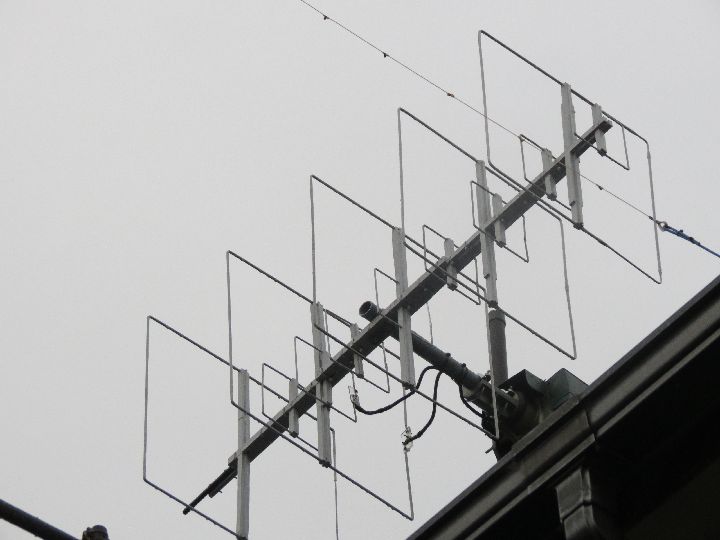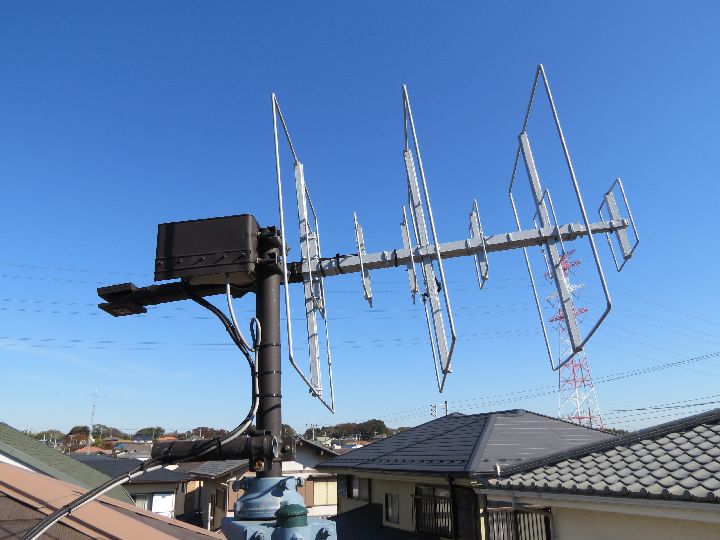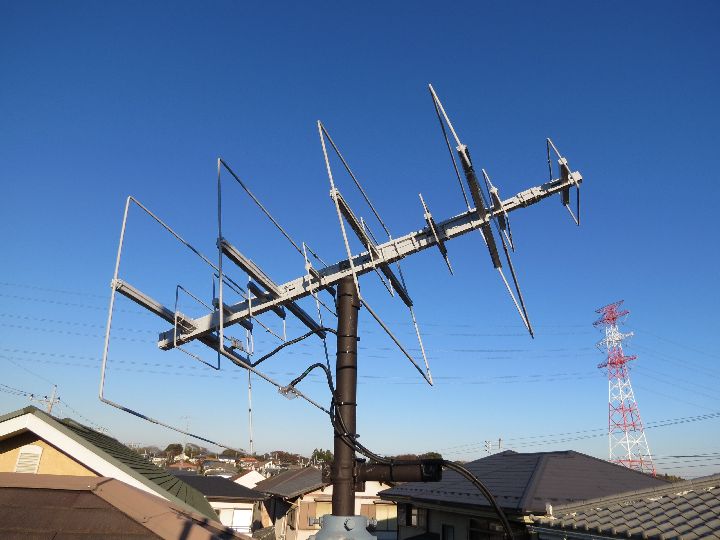JK1SXR
=>Japanese
Return to "A. Home"
1. From yagi to
quad antennas
2. Quad antenna
modification 1
3. Quad antenna
modification 2
4. Combined quad
dimensions
Return to "A. Home"
1. From yagi to
quad antennas
2. Quad antenna
modification 1
3. Quad antenna
modification 2
4. Combined quad
dimensions
B2. V/U antennas for low earth orbit satellites
3. LEO sat ant. modification 2 / Removal of elevation rotator1) 145 MHz 5 elements / 435 MHz 8 elements
 At the news of approaching typhoons, No. 26 & No. 27, the satellite antenna was lowered. Taking this opportunity, the antenna was again modified to yet another configuration, 145 MHz 5 elements and 435 MHz 8 elements.
At the news of approaching typhoons, No. 26 & No. 27, the satellite antenna was lowered. Taking this opportunity, the antenna was again modified to yet another configuration, 145 MHz 5 elements and 435 MHz 8 elements.The new one is as in the picture. Very stable communications were obtained.
However, because of this size, the azimuth rotator brake-torque was exceeded by the horizontal bending moment at high wind, and it became necessary to correct the rotator azimuth after high wind.
2) 145 MHz 3 elements / 435 MHz 6 elements / in front of rotator
 Another configuration was also tried, with the original design of 145 MHz 3 elements and 435 MHz 6 elements, except for that the whole antenna is placed in front of the elevation rotator.
Another configuration was also tried, with the original design of 145 MHz 3 elements and 435 MHz 6 elements, except for that the whole antenna is placed in front of the elevation rotator.Though the performance, of course, was same as before, the overall configuration looks awkward, as it requires additional heavy weights at the rear of the antenna.
3) 145 MHz 4 elements - 435 MHz 8 elements / Elevation angle fixed
 When the elevation rotator is adopted, it is necessary to consider the clearance between the antenna rear and the structure beneath the antenna. Further, it becomes difficult to make the antenna gravity center and windage center as close as possible.
When the elevation rotator is adopted, it is necessary to consider the clearance between the antenna rear and the structure beneath the antenna. Further, it becomes difficult to make the antenna gravity center and windage center as close as possible.While, in my actual operations, there were many such occasions that after the antenna elevation angle was set at around 30 degrees, and thereafter I forgot adjusting the ecevation angle. Still, in most cases, the communications have been possible continusly without any problem, even to the satellite passes of maximum elevation angles of 70 - 80 degrees.
In the communications through low-earth-orbit satellites with this degree of directivity antenna, it looks that the adoption of elevation rotator is too burdensome compared with what we can gain from it.
Therefore I decided to dismantle the elevation rotator and made another antenna,145 MHz 4 elements and 435 MHz 8 elements with elevation angle of 20 degrees fixed.
The performance is satisfactory, in most cases, stable communicaitons were obtained even at such times as immediately after AOS, just before LOS, satelliete elevation angles of 70 - 80 degrees.
Mechanically, the windage center and gravity center becomes to fall on almost same positions. And the smaller antenna-top weight gives a much safer outlook.
As of H25/2013 November
Copyright © 2013 JK1SXR/abemasa. All Rights reserved.